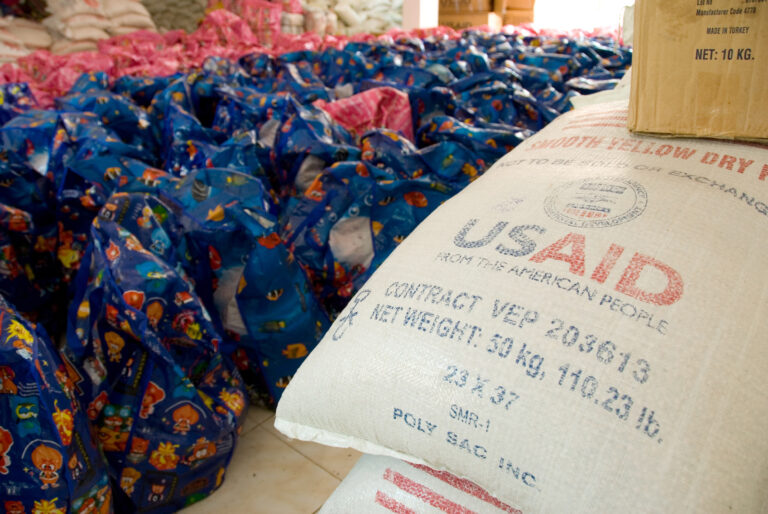
The Israeli-Palestinian conflict has profound implications for the region’s economic stability and development. Based on a complex interplay of historical, political and cultural factors, this conflict has led to recurring violence, political instability and significant economic disruption for both Israelis and Palestinians. The prolonged nature of this conflict has led to widespread economic consequences, affecting every aspect of daily life and economic activity. But how has the prolonged conflict between Israel and Palestine devastated their economies?
Performance of Israel’s GDP
According to an initial estimate by the Central Bureau of Statistics, Israel’s Gross Domestic Product (GDP) increased by 3.3% in the first quarter of 2024, with a year-on-year growth of 14.1%. This figure follows a drastic annual decline of 21.7% in the fourth quarter of 2023, following the onset of the conflict triggered by the tragic events of October 7th. The economic rebound was anticipated but proved stronger than most analysts had estimated. Despite significant growth, the recovery remains partial: in the first quarter of 2024, GDP was still 1.4% lower than in the corresponding quarter of 2023, while GDP per capita decreased by 3.1%. The GDP of the private sector, excluding housing services and the public sector, was 4.1% lower compared to the first quarter of 2023. Data on consumption and investments indicate the ongoing effects of the war: private consumption increased by 26.3% after the collapse in the previous quarter but remains lower than the pre-war period and similar to 2021 levels. Public consumption rose by 7.1%, following an unprecedented increase of 86% in the previous quarter, primarily due to defense spending. Import and export data also present a mixed picture: imports of goods and services increased by 32.7% in the first quarter of 2024, while exports decreased by 11%.
In January, the Bank of Israel, in its most optimistic scenario, predicted a GDP growth of 2% in 2024, which translates into negative growth considering the natural population increase. More recent estimates are more pessimistic: The International Monetary Fund (IMF) has lowered its growth forecast for Israel to just 1.6%, down from the previous prediction of 3.1%. The U.S. rating agency Moody’s downgraded the credit rating of the five largest Israeli banks from A2 to A3. Previously, the same agency had downgraded Israel’s sovereign credit rating from A1 to A2, the first downgrade in the country’s history, due to the economic impact of the conflict.
Israel’s Macroeconomic Parameters
The Monetary Committee of the Bank of Israel, chaired by Governor Prof. Amir Yaron, has announced that the interest rate will remain unchanged at 4.5%, following a reduction of 0.25% in January. The Bank of Israel’s research department expects inflation of 2.7% in 2024, up from its previous forecast of 2.5%, and inflation of 2.3% in 2025, up from the 2% expected earlier. The Bank expects an interest rate of 3.75% in the first quarter of 2025 compared to 4% previously forecast. In December, notable price decreases were observed in sectors such as fresh fruit, culture, and entertainment, all down by 2.2%, fashion and footwear (-1.8%), and furniture and appliances (-0.7%). Conversely, there were significant price increases in fresh vegetables (+3.2%) and housing costs, which rose by 0.3%. Overall, in 2023, the prices of fruits and vegetables increased by 13.6%, food prices by 4.2%, transportation and communications by 3.8%, housing costs by 3.5%, healthcare by 3.2%, housing maintenance by 2.6%, and education, entertainment, and culture by 1.8%. In contrast, the prices of clothing and footwear dropped by 10.4%, with decreases also noted in furniture and appliances (4.3%).
The housing price index, published by the Central Bureau of Statistics of Israel, increased by 3.6% between November 2023 and March 2024, after a 2.5% decline over the previous 10 months. The average price of an apartment in Israel in the first quarter of 2024 reached 2.23 million shekels (557,000 euros), following market fluctuations in the first three quarters of 2023. The number of residential real estate transactions conducted in the first three quarters of 2023 averaged about 6,000 homes per month, the lowest in 20 years. The conflict that began following the tragic events of October 7, 2023, has directly contributed to the fact that the weight of new apartments purchased currently covers around 50% of the entire market, for the first time since the Covid pandemic in 2020. In 2020 the motivation for purchasing new apartments was linked to the need to work from home and the extra space required to make prolonged closure easier. During the war, however, the need for reinforced safety rooms in houses increased significantly, and this can only be met by new or second-hand apartments, but built within the last 20 years, since housing built before the 1990s was smaller and did not satisfy the safety requirements mentioned above. The amount of new apartments purchased in the first quarter of this year on the open market increased by 40%, while for second-hand apartments the purchase amount in this quarter increased by only 6%.
Examples of Price Changes in Everyday Life
- A kilo of frozen chicken legs, available only once or twice a week, has jumped to the Israeli shekel equivalent of $20, more than 10 times its pre-war price.
- ● Cooking gas, when available, costs $35 a pound, up from $1.60;
- ● Car batteries, used to charge phones and electric lamps, sell for more than $500 each;and a gallon of gas, when available, costs $22.
- ● Shisha tobacco costs $50 for a single use or $2,500 per kilo, while the asking price foran Egyptian-brand cigarette from Karelia peaked at $140 earlier this year but it is currently around $20.

Fiscal Deficit and Public Spending in Israel
Israel’s fiscal deficit continued to grow in May, standing at 7.2% of GDP over the past 12 months, equivalent to 137.7 billion shekels (34.4 billion euros). This represents an increase from the 6.9% of GDP recorded at the end of the previous month. The deficit target set for the end of 2024 is 6.6%, but many experts are uncertain about the chances of reaching this goal. Since the beginning of the year, the cumulative fiscal deficit has amounted to approximately 47.6 billion shekels, a significant deterioration compared to the surplus of 13 billion shekels during the same period in 2023. Public spending since the start of the year has reached 249.3 billion shekels, a 35% increase compared to the previous year. This is primarily due to high defense spending and increased expenditures by civilian ministries, both heavily influenced by the ongoing conflict.
The Ministry of Finance predicts that the deficit will reach its peak by September, and then begin to progressively reduce, approaching the 6.6% target set in the state budget approved last March.
Israel: Economic Contraction and Labor Market Dynamics
In the fourth quarter of 2023, coinciding with the start of the conflict, Israel’s economy contracted by 20% year-on-year. The most significant reduction was recorded in investments, which fell by 70%, while private consumption recorded a decrease of 27% during the same period. During the course of 2023, Israel imported goods and services with a total value of 84.3 billion euros, marking a decline of 17.2% compared to the previous year. An example of this trend is represented by Italy, which saw the value of its exports to Israel fall from 3.4 to 3.2 billion euros in 2023, with a relative decrease of 4.2%, less pronounced than in the overall decline in Israeli imports. Specifically, imports from Italy decreased in the automotive (20.1%), plastic materials (20.3%) and ceramic products (22%) sectors. In contrast, imports of pharmaceutical products (+30%), pastry products (+23%) and cosmetics (+23.8%) increased.
In the labor market, as of April 2024, the unemployment rate in Israel remained stable at 3.4%, with a slight increase of 0.1% in the employment rate for people aged 15 years and older. The overall unemployment rate, which includes workers on unpaid leave, fell to 3.8% from 4.1% in March, with fewer than 170,000 unemployed under the expanded definition. This return to pre- conflict unemployment levels marks a post-conflict recovery, despite the temporary absence of more than 400,000 people from work due to the conscription of reservists and the economic impacts of the conflict. Currently, only 7% of those temporarily absent from work are due to military service, down from more than 20% in March.
The labor market remains tight, with 137,000 open positions in April compared to 134,000 in March. The labor shortage primarily affects the commercial, hospitality, and food industries, while the technology sector has not experienced significant changes in job vacancies. The construction sector, however, suffers from a severe shortage of foreign labor, leading to increased wages and housing costs.
Impact of the Conflict on the Palestinian Economy
In the Palestinian territories, the conflict has affected all economic sectors and devastated critical infrastructure, including housing, schools, healthcare facilities, water and sanitation services, and the electrical grid. Poverty and unemployment, already severe in Gaza before the war, have worsened drastically, and the socioeconomic outlook for the territory is very pessimistic. Official data from the Palestinian Central Bureau of Statistics (PCBS) confirms that the economy contracted by 5.5% in 2023 compared to the previous year, equivalent to a loss of $1.8 billion. As expected, Gaza’s economy suffered most of the decline due to the near-total disruption of economic activities in the Strip, with a contraction of 22.6% in 2023. In the fourth quarter of 2023 alone, Gaza’s GDP faced a decline of more than 80% compared to the same period in 2022. The services, trade and agriculture sectors, which are among the largest contributors to Gaza’s GDP, declined by 63%, 91% and 93% respectively in the fourth quarter of 2023. The conflict has also worsened living standards and increased disparities between Gaza and the West Bank. Per capita GDP in the Palestinian territories was $3,360 in 2023, down 12% from 2022. In Gaza, per capita GDP fell by 28% to $1,084, representing only one-fifth of that in the West Bank. Overall, Gaza’s per capita income in 2023 was the lowest ever recorded.
In the early months of this year, the Palestinian economy continued to suffer a severe shock due to the intensity of the conflict and its aftermath. The economy is expected to contract between 6.5% and 9.4% over the course of 2024. According to the joint EU-UN-World Bank’s Interim Damage Assessment, the cumulative estimated cost of damages from the conflict as of late January 2024 amounts to over $18 billion. Assuming reconstruction does not begin until 2025, economic contraction in Gaza is expected to worsen significantly in 2024, exceeding 50% year- on-year due to the destruction of fixed capital. The West Bank economy is also expected to remain under pressure through 2024 due to movement and access restrictions and the Palestinian Authority’s ongoing fiscal crisis.
The Palestine Monetary Authority (PMA) Business Cycle Index for the West Bank in the first quarter of 2024 is significantly lower than in September 2023, despite a slight temporary improvement in March attributed to increased production and sales during Ramadan. The ongoing conflict in Gaza has caused profound damage to private sector infrastructure, effectively destroying the production capacity of many private companies. Economic activity in Gaza remains largely paralyzed, with major economic sectors having completely ceased production and sales, except for some activities in humanitarian relief, health, bakeries and the domestic trade of food and medicine.

Price Trends in Gaza in 2024
In April 2024, prices in Gaza recorded their first decline since the conflict began, although they remained significantly higher than pre-October 7 levels. According to data from the Palestinian Central Bureau of Statistics, the consumer price index (CPI) in Gaza decreased by 5.4% compared to the previous month, thanks to the increase in humanitarian aid deliveries. Food prices, in particular, fell 20.7% compared to March. However, from October 2023 until the end of May 2024, the consumer price index in Gaza increased dramatically by 240% due to the ongoing Israeli aggression.
Overall, the CPI for Palestine in May 2024 increased by 13.71% compared to April 2024, with an increase of 36.23% in the Gaza Strip, a slight increase of 0.05% in Jerusalem, and a decrease by 0.64% in the West Bank.
Changes in the Palestinian CPI in May 2024 are attributable to changes in the prices of the following spending subcategories compared to the previous month:
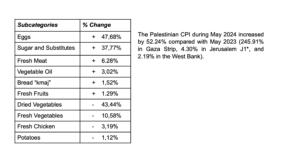
Palestine: Inflation, Trade and Labor Sector
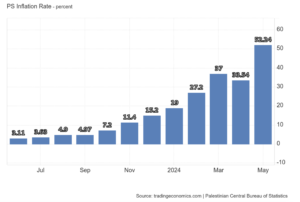
During May 2024, Palestine’s annual inflation rate jumped to 52.24%, up from 33.5% in the previous month, marking the highest ever since 1998, due to ongoing Israeli aggression. The significant increase was mainly driven by food and non-alcoholic drinks (36.4% compared to 34.5% in April), housing and public services (34.83% compared to 9%), transport (45.23% compared to at 40.1%), alcoholic beverages and tobacco (581.02% compared to 290.7%) and health (14.92% compared to 13%).
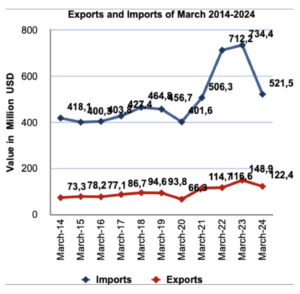
Exports decreased by 18% in March 2024 compared to the corresponding value of the previous year, reaching $122.4 million. At the same time, exports to other countries decreased by 23% compared to the same period in 2023.
Imports decreased the most, 29% lower than imports in March 2023, reaching 512.4 million dollars. As a result, imports from other countries also decreased (34% lower than in March 2023).
Regarding the labor sector, since 7 October 2023, unemployment rates have reached unprecedented levels: estimates show that unemployment rates even increased to 75% in the fourth quarter of 2023, compared to 46% in the third quarter of the same year. This impact was not only reflected in the Gaza Strip, but also had an impact in the West Bank, even if it was less affected: the number of unemployed increased, reaching 317 thousand people in the fourth quarter of 2023, compared to around 129 thousand in the third quarter of the same year.
By Davide Russello
Italian Version
Il Costo del Conflitto: L’Impatto Devastante sulle Economie di Israele e Palestina
Il conflitto israelo-palestinese ha profonde implicazioni per la stabilità economica e lo sviluppo della regione. Radicato in una complessa interazione di fattori storici, politici e culturali, questo conflitto ha portato a violenze ricorrenti, instabilità politica e significativi disagi economici sia per gli israeliani che per i palestinesi. La natura prolungata di questo conflitto ha comportato conseguenze economiche diffuse, colpendo ogni aspetto della vita quotidiana e dell’attività economica. Ma in che modo il prolungato conflitto tra Israele e Palestina ha devastato l’economia Israeliana e Palestinese ?
Andamento del PIL Israeliano
Secondo una stima iniziale dell’Ufficio Centrale di Statistica, il prodotto interno lordo (PIL) di Israele è aumentato del 3,3% nel primo trimestre del 2024, con un incremento del 14,1% su base annua. Questo dato segue un drastico crollo del 21,7% su base annua nel quarto trimestre del 2023, a seguito dell’inizio del conflitto scatenato dai tragici eventi del 7 ottobre. Il rimbalzo dell’economia era previsto, ma è stato più forte di quanto stimato dalla maggior parte degli analisti. Nonostante la crescita significativa, la ripresa rimane parziale: nel primo trimestre del 2024, il PIL è ancora inferiore dell’1,4% rispetto al trimestre corrispondente del 2023, mentre il PIL pro capite è diminuito del 3,1%. Il PIL del settore privato, escludendo i servizi abitativi e il settore pubblico, è stato inferiore del 4,1% rispetto al primo trimestre del 2023. I dati su consumi e investimenti indicano il perdurare degli effetti della guerra: i consumi privati sono aumentati del 26,3% dopo il crollo del trimestre precedente, ma sono ancora bassi rispetto al periodo prebellico e simili ai livelli del 2021. I consumi pubblici sono aumentati del 7,1%, dopo un incremento senza precedenti dell’86% nel trimestre precedente, principalmente a causa delle spese per la difesa. Anche i dati su importazioni ed esportazioni presentano un quadro contrastante: le importazioni di beni e servizi sono aumentate del 32,7% nel primo trimestre del 2024, mentre le esportazioni sono diminuite dell’11%.
A gennaio, la Banca d’Israele, nel suo scenario più ottimistico, aveva previsto una crescita del PIL del 2% nel 2024, il che si traduce in una crescita negativa considerando l’aumento naturale della popolazione. Le stime più recenti sono più pessimistiche. Il Fondo Monetario Internazionale (FMI) ha ridotto le sue previsioni di crescita per Israele a solo l’1,6%, rispetto al 3,1% della previsione precedente. L’agenzia di rating statunitense Moody’s ha abbassato di un livello il merito di credito delle cinque maggiori banche israeliane, portandolo da A2 ad A3. La stessa agenzia aveva precedentemente abbassato il rating del credito sovrano di Israele da A1 ad A2, il primo declassamento nella storia del Paese, citando il potenziale impatto economico negativo di una possibile escalation del conflitto.
Parametri Macroeconomici di Israele
Il Comitato monetario della Banca d’Israele, presieduto dal Governatore Prof. Amir Yaron, ha annunciato che manterrà invariato il tasso di interesse al 4,5%, ridotto precedentemente a gennaio dello 0,25%. Il dipartimento di ricerca della Banca d’Israele prevede un’inflazione del
2,7% nel 2024, in aumento rispetto alla precedente previsione del 2,5%, e un’inflazione del 2,3% nel 2025, rispetto al 2% previsto in precedenza. La Banca prevede un tasso di interesse del 3,75% nel primo trimestre del 2025 rispetto al 4% previsto in precedenza.
Notevoli cali dei prezzi a dicembre si sono registrati nei settori della frutta fresca, della cultura e dello spettacolo, entrambi in calo del 2,2%, dei prezzi della moda e delle calzature (-1,8%) e dei mobili e degli elettrodomestici (-0,7%). Tuttavia, notevoli sono stati gli aumenti dei prezzi delle verdure fresche (+3,2%) e dei costi immobiliari, che sono aumentati dello 0,3%. Nel 2023, complessivamente, i prezzi di frutta e verdura sono aumentati del 13,6%, così come i prezzi dei generi alimentari (4,2%), dei trasporti e delle comunicazioni (3,8%), dei costi abitativi (3,5%), della sanità (3,2%), della manutenzione degli alloggi (2,6%) e istruzione, intrattenimento e cultura (1,8%). Nel 2023 i prezzi dell’abbigliamento e delle calzature sono scesi del 10,4% e si sono registrati cali dei prezzi dei mobili e degli elettrodomestici (4,3%). L’indice dei prezzi delle abitazioni pubblicato dall’Ufficio Centrale di Statistica israeliano è aumentato del 3,6% tra novembre 2023 e marzo 2024, dopo essere sceso del 2,5% nei 10 mesi precedenti. Il prezzo medio di un appartamento in Israele nel primo trimestre del 2024 ha raggiunto 2,23 milioni di shekel (557.000 euro), dopo che il mercato ha vacillato nei primi tre trimestri del 2023. Il numero di compravendite immobiliari residenziali effettuate nei primi tre trimestri del 2023, infatti, è stato di circa 6.000 abitazioni al mese, un minimo che non si vedeva da 20 anni. Il conflitto avviato in seguito ai tragici eventi del 7 ottobre 2023, ha contribuito direttamente al fatto che il peso dei nuovi appartamenti acquistati copra attualmente circa il 50% dell’intero mercato, per la prima volta dalla pandemia di Covid nel 2020. Nel 2020 la motivazione per l’acquisto di nuovi appartamenti era collegata alla necessità di lavorare da casa e allo spazio in più richiesto per rendere più semplice la chiusura prolungata. Durante la guerra, invece, è aumentata notevolmente la necessità di locali di sicurezza rinforzati nelle case, e questa può essere soddisfatta solo da appartamenti nuovi oppure di seconda mano, ma costruiti negli ultimi 20 anni, poiché gli alloggi costruiti prima degli anni ’90 erano più piccoli e non soddisfacevano le esigenze di sicurezza sopra ricordate. La quantità di nuovi appartamenti acquistati nel primo trimestre di quest’anno sul mercato libero è aumentata del 40%, mentre per gli appartamenti di seconda mano l’importo di acquisto in questo trimestre è aumentato solo del 6%.
Qualche Esempio dei Cambiamenti di Prezzi nella Vita Quotidiana
- ● Un chilo di cosce di pollo congelate, disponibili solo una o due volte alla settimana, è balzato all’equivalente in shekel israeliani di 20 dollari, più di 10 volte il suo prezzo prebellico.
- ● Il gas da cucina, quando disponibile, costa 35 dollari al chilo, rispetto a 1,60 dollari;
- ● le batterie per auto, utilizzate per caricare telefoni e lampade elettriche, vengono vendute a più di 500 dollari ciascuna; e un litro di benzina, quando disponibile, costa 22
dollari.
- ● Il tabacco Shisha costa 50 dollari per un solo uso o 2.500 dollari al chilo, mentre il
prezzo richiesto per una sigaretta di marca egiziana della Carelia ha raggiunto il picco di 140 dollari all’inizio di quest’anno e attualmente è di circa 20 dollari.
Deficit Fiscale e Spesa Pubblica in Israele
Il deficit fiscale di Israele ha continuato a crescere a maggio, attestandosi al 7,2% del PIL negli ultimi 12 mesi, equivalenti a 137,7 miliardi di shekel (34,4 miliardi di euro). Questo rappresenta un aumento rispetto al 6,9% del PIL registrato alla fine del mese precedente. L’obiettivo di deficit fissato per la fine del 2024 è del 6,6%, ma molti esperti sono incerti sulle possibilità di raggiungere tale obiettivo. Dall’inizio dell’anno, il deficit fiscale cumulativo è stato di circa 47,6 miliardi di shekel, un netto peggioramento rispetto al surplus di 13 miliardi di shekel dello stesso periodo nel 2023. La spesa pubblica dall’inizio dell’anno ha raggiunto 249,3 miliardi di shekel, con una crescita del 35% rispetto all’anno precedente. Questo aumento è principalmente attribuibile alle elevate spese per la difesa e per i ministeri civili, entrambi fortemente influenzati dal conflitto in corso. Nel frattempo, le entrate statali sono cresciute solo del 2%, raggiungendo circa 201,6 miliardi di shekel. Il Ministero delle Finanze prevede che il deficit raggiungerà il suo picco entro settembre, per poi iniziare a ridursi progressivamente, avvicinandosi all’obiettivo del 6,6% stabilito nel bilancio statale approvato lo scorso marzo.
Israele: Contrazione Economica e Dinamiche del Mercato del Lavoro
Nel quarto trimestre del 2023, coincidente con l’inizio del conflitto, l’economia israeliana ha subito una contrazione del 20% su base annua. La riduzione più significativa è stata registrata negli investimenti, che sono calati del 70%, mentre i consumi privati hanno registrato una diminuzione del 27% durante lo stesso periodo. Durante il corso del 2023, Israele ha importato beni e servizi per un valore totale di 84,3 miliardi di euro, segnando un calo del 17,2% rispetto all’anno precedente. Un esempio di questa tendenza è rappresentato dall’Italia, che ha visto il valore delle sue esportazioni verso Israele scendere da 3,4 a 3,2 miliardi di euro nel 2023, con una diminuzione relativa del 4,2%, meno accentuata rispetto al calo complessivo delle importazioni israeliane. Specificamente, sono diminuite le importazioni dall’Italia nei settori automobilistico (20,1%), delle materie plastiche (20,3%) e dei prodotti ceramici (22%). In controtendenza, le importazioni di prodotti farmaceutici (+30%), per pasticceria (+23%) e cosmetici (+23,8%) sono aumentate.
Nel mercato del lavoro, ad aprile 2024, il tasso di disoccupazione in Israele è rimasto stabile al 3,4%, con un lieve aumento dello 0,1% nel tasso di occupazione per le persone di età pari o superiore ai 15 anni. Il tasso di disoccupazione complessivo, che include i lavoratori in congedo non retribuito, è sceso al 3,8% rispetto al 4,1% di marzo, con meno di 170.000 disoccupati secondo la definizione estesa. Questo ritorno ai livelli di disoccupazione precedenti al conflitto segna una ripresa post-bellica, nonostante l’assenza temporanea di oltre 400.000 persone dal lavoro a causa dell’arruolamento di riservisti e degli impatti economici del conflitto. Attualmente, solo il 7% degli assenti temporanei dal lavoro è dovuto al servizio militare, in calo rispetto a oltre il 20% di marzo. Il mercato del lavoro rimane teso, con 137.000 posti vacanti ad aprile, rispetto ai 134.000 di marzo. La carenza di manodopera colpisce principalmente i settori commerciale, dell’ospitalità e dell’industria alimentare, mentre il settore tecnologico non ha registrato variazioni significative nei posti vacanti. Il settore edile, invece, soffre una grave mancanza di manodopera straniera, causando un aumento dei salari e dei costi degli alloggi.
Impatto del Conflitto sull’Economia Palestinese
Nel territorio Palestinese il conflitto ha colpito tutti i settori economici e devastato infrastrutture vitali come abitazioni, scuole, strutture sanitarie, servizi idrici e igienico-sanitari, e la rete elettrica. La povertà e la disoccupazione, già gravi a Gaza nel periodo pre-bellico, sono peggiorate drasticamente, e le prospettive socioeconomiche del territorio sono molto pessimistiche. I dati ufficiali del Palestinian Central Bureau of Statistics (PCBS) confermano che l’economia si è contratta del 5,5% nel 2023 rispetto all’anno precedente, equivalente a una perdita di 1,8 miliardi di dollari.
Come previsto, l’economia di Gaza ha subito la maggior parte del declino a causa dell’interruzione quasi totale delle attività economiche nella Striscia, con una contrazione del 22,6% nel 2023. Solo nel quarto trimestre del 2023, il PIL di Gaza è crollato di oltre l’80% rispetto allo stesso periodo del 2022. I settori dei servizi, del commercio e dell’agricoltura, che sono tra i maggiori contributori al PIL di Gaza, sono diminuiti rispettivamente del 63%, 91% e 93% nel quarto trimestre del 2023. Il conflitto ha anche peggiorato gli standard di vita e aumentato le disparità tra Gaza e la Cisgiordania. Il PIL pro capite nei territori palestinesi è stato di 3.360 dollari nel 2023, il 12% in meno rispetto al 2022. A Gaza, il PIL pro capite è diminuito bruscamente del 28%, raggiungendo 1.084 dollari, rappresentando solo un quinto di quello della Cisgiordania. In generale, il reddito pro capite di Gaza nel 2023 è stato il più basso mai registrato.
Nei primi mesi di quest’anno, l’economia palestinese ha continuato a subire un forte shock a causa della gravità del conflitto e delle sue conseguenze. Si prevede che l’economia si contrarrà tra il 6,5% e il 9,4% nel corso del 2024. Secondo la valutazione provvisoria dei danni congiunta di UE, ONU e Banca Mondiale, il costo stimato dei danni al gennaio 2024 ammonta a oltre 18 miliardi di dollari. Presumendo che la ricostruzione non inizi prima del 2025, la contrazione economica a Gaza dovrebbe peggiorare significativamente nel 2024, superando il 50% su base annua a causa della distruzione del capitale fisso. Anche l’economia della Cisgiordania dovrebbe rimanere sotto pressione per tutto il 2024 a causa delle restrizioni di movimento e accesso e della crisi fiscale continua dell’Autorità Palestinese.
L’Indice del Ciclo Economico della Palestine Monetary Authority (PMA) per la Cisgiordania nel primo trimestre del 2024 è significativamente inferiore rispetto a settembre 2023, nonostante un lieve miglioramento temporaneo a marzo attribuito all’aumento della produzione e delle vendite in occasione del Ramadan. Il conflitto in corso a Gaza ha causato profondi danni alle infrastrutture del settore privato, annientando di fatto la capacità produttiva di molte aziende private. L’attività economica a Gaza rimane in gran parte paralizzata, con i principali settori economici che hanno cessato completamente la produzione e le vendite, ad eccezione di alcune attività nel soccorso umanitario, nella salute, nei panifici e nel commercio interno di cibo e medicine.
Andamento dei Prezzi a Gaza nel 2024
Ad aprile 2024, i prezzi a Gaza hanno registrato il primo calo dall’inizio del conflitto, pur rimanendo significativamente più alti rispetto ai livelli precedenti al 7 ottobre. Secondo i dati del Palestinian Central Bureau of Statistics, l’indice dei prezzi al consumo (CPI) a Gaza è diminuito del 5,4% rispetto al mese precedente, grazie all’aumento delle consegne di aiuti umanitari. I prezzi degli alimenti, in particolare, sono scesi del 20,7% rispetto a marzo. Tuttavia, dall’ottobre 2023 fino alla fine di maggio 2024, l’indice dei prezzi al consumo a Gaza è aumentato drasticamente del 240% a causa dell’aggressione israeliana in corso.
Nel complesso, il CPI per la Palestina a maggio 2024 è aumentato del 13,71% rispetto ad aprile 2024, con un incremento del 36,23% nella Striscia di Gaza, un lieve aumento dello 0,05% a Gerusalemme, e una diminuzione dello 0,64% in Cisgiordania.
I cambiamenti nel CPI palestinese a maggio 2024 sono attribuibili alle variazioni dei prezzi delle seguenti sottocategorie di spesa rispetto al mese precedente:
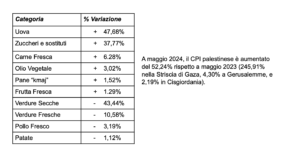
Palestina: Inflazione, Commercio e Settore Lavorativo
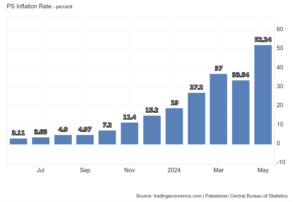
A maggio 2024, il tasso di inflazione annuale della Palestina è schizzato al 52,24%, rispetto al 33,5% del mese precedente, segnando il valore più alto mai registrato dal 1998, a causa dell’aggressione israeliana in corso. L’incremento significativo è stato principalmente trainato da cibo e bevande analcoliche (36,4% rispetto al 34,5% ad aprile), abitazioni e servizi pubblici (34,83% rispetto al 9%), trasporti (45,23% rispetto al 40,1%), bevande alcoliche e tabacco (581,02% rispetto al 290,7%) e salute (14,92% rispetto al 13%).

Le esportazioni sono diminuite del 18% a Marzo 2024 rispetto al valore corrispondente dell’anno precedente, raggiungendo 122,4 milioni di dollari. Allo stesso tempo, le esportazioni verso altri paesi sono diminuite del 23% rispetto allo stesso periodo nel 2023. Diminuiscono maggiormente le importazioni, inferiori del 29% rispetto alle importazioni nel marzo 2023, arrivando a 512,4 milioni di dollari. Di conseguenza, sono anche diminuite le importazioni da altri paesi (inferiori del 34% rispetto a marzo 2023).
Per ciò che riguarda il settore lavorativo, dal 7 ottobre 2023 i tassi di disoccupazione hanno raggiunto livelli senza precedenti: le stime mostrano che i tassi di disoccupazione sono addirittura aumentati al 75% nel quarto trimestre del 2023, rispetto al 46% del terzo trimestre dello stesso anno. Questo impatto non si è riflettuto solo nella Striscia di Gaza, ma ha avuto un impatto anche in Cisgiordania, sebbene in misura minore: il numero di disoccupati è aumentato, raggiungendo 317 mila persone nel quarto trimestre del 2023, rispetto a circa 129 mila nel terzo trimestre dello stesso anno.
Davide Russello.



